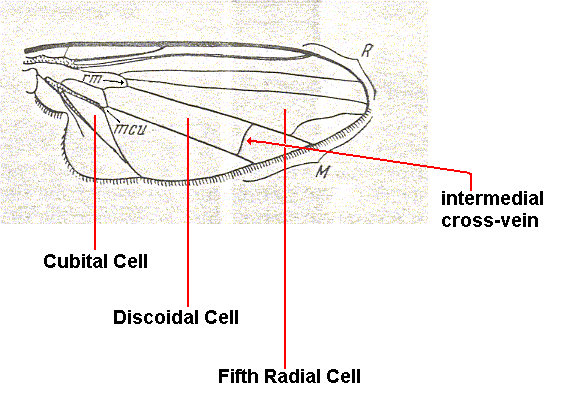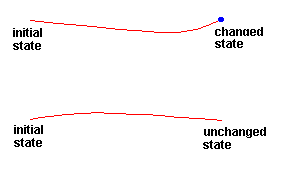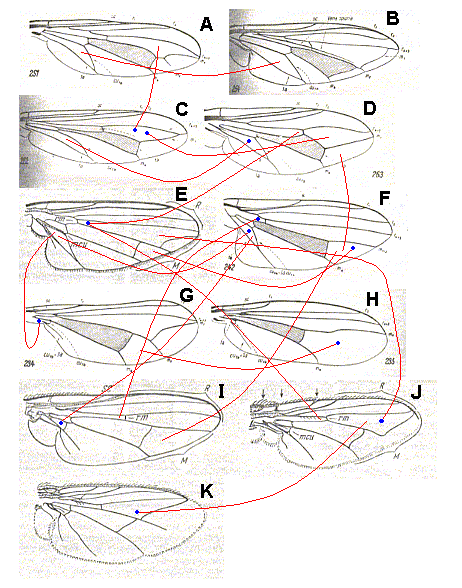
Interspecific Noëtic Interactions

Figure above : Wing of Clythia picta MEIG (Clythiidae).
The wing-venation of this form is close to the general venational groundplan of cyclorraphic flies.
The Radial Sector is, as in all cyclorraphic flies, two-branched, that is, it consists of two long more or less parallel branches. The cell lying directly below the second branch of the Radial Sector (R5) is called the "fifth radial cell". Posteriorly it is bounded by the anterior main branch of the Media. The latter branch is connected with the second branch of the Radial Sector by the cross-vein r-m ( = ta). The position of this cross-vein is here rather specialized because it has shifted somewhat toward the wing-base. The two main branches of the media enclode the discoidal cell ( = intermedial cell). Distally this cell is closed by the intermedial cross-vein ( = tp).
The posterior medial branch is connected with the anterior cubital branch (CuA) by the cross-vein m-cu ( = tb). CuA bends toward the first anal vein (1A) and coalesces with it. The common stalk (CuA + 1A) of these two veins becomes longer in many other species (of Cyclorrapha and others) implying that the enclosed cell is contracting toward the wing-base. This enclosed cell we earlier had -- following HENNIG -- called the "anal cell", but it is better -- following ROHDENDORF -- to call it the "cubital cell".
In diagram 1 (further down) we indicate a number of 'character movements' that can formally be distinguished between the venational patterens of some cyclorraphic flies (and a few orthorraphic ones). In fact we observe either a constancy of the state of a given venational character, or we see a change of the state (i.e. a transformation from a plesiomorphous state to an apomorphous state) of a given venational character. For example, the (plesiomorphous) state of the cubital cell has changed (into a more apomorphous state) when the cell's contraction (toward the wing-base) has proceeded further. The changed -- apomorphous -- state is indicated, in the mentioned diagram, by a blue point at the end of the (red) line connecting this state with the initial -- plesiomorphous -- state (of the same character). A red line without such a blue point connects the same states of the given character :

In all this we assume that there cannot take place transitions that go from an apomorphic to a plesiomorphic state of a given character, that is, evolution will never be (exactly) reversed.
In the diagram that follows, that is, in the mentioned Diagram 1, wings of a number of (recent) cyclorraphic (and some other) species of flies are compared with each other as to their wing-venation :
A -- Nephrocerus scutellatus MACQ. ( Dorilaidae [= Pipunculidae] ) (Cyclorrapha). (After HENNIG 1954),
B -- Syrphus ribesii L. (Syrphidae) (Cyclorrapha). (After HENNIG 1954),
C -- Conops flavipes L. (Conopidae) (Cyclorrapha). (After HENNIG 1954),
D -- Sicus ferrugineus L. (Conopidae) (Cyclorrapha). (After HENNIG 1954)
E -- Clythia picta MEIG. (Clythiidae) (Cyclorrapha). (After ROHDENDORF 1951),
F -- Callimyia speciosa MEIG. (Clythiidae) (Cyclorrapha). (After HENNIG 1954),
G -- Sciopus albifrons MEIG. (Dolichopodidae) (Orthorrapha). (After HENNIG 1954),
H -- Dolichopus picipes MEIG. (Dolichopodidae) (Orthorrapha). (After HENNIG 1954),
I -- Fannia sp. (Anthomyiidae) (Cyclorrapha). (After ROHDENDORF 1951),
J -- Orthellia sp. (Muscidae) (Cyclorrapha). (After ROHDENDORF 1951),
K -- Linnaemyia vulpina FALL. (Larvaevoridae) (Cyclorrapha). (After ROHDENDORF 1951).
Comparison of the states of certain venational characters -- as present in the venational groundplan of the Cyclorrapha, see figure above -- is expressed in terms of noëtic interactions (taking place in the Implicate Order, and the results projected into the Explicate Order).

Diagram 1 : Morphological relations between the states of a number of characters as they are found in the wing-venation of recent cyclorraphic (and a few other) flies :
So in addition to the one given venation being, as a whole, evolutionarily derived from some other (whole) venation (which derivation was discussed earlier), some p a r t s, and only these parts, of a given venation are derived from the corresponding parts of another venation. And the latter phenomenon is the result of noëtic contact or interaction of the formal contents of two or more (noëtically more or less closely related ) species as these contents are present in the Implicate Order as noëtic entities, structures or patterns.
Back to main text